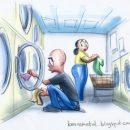Let me tell you a story about what a guy named Peter Guber has learned about storytelling. Peter Guber is a successful film producer whose films have earned over 3 billion dollars and have captured 50 Academy Award nominations. He is also an owner of two major league sports franchises. So he’s got some cred.
In his book, Tell to Win: Connect, Persuade, and Triumph with the Hidden Power of Story, Peter talks about the “Me to We” factor in developing a persuasive story, one designed to influence behavior.
He emphasizes that when creating a story designed to move a person, it’s critically important to highlight an interest, goal, or problem that both the storyteller and the audience share. Guber makes the point that this process ignites the audience’s empathy, trust and interest.
Ultimately the “me-to-we” factor creates a sense that the listener and the teller share the same problem. This common ground allows the storyteller and the listener to connect with one another, both emotionally and intellectually. To quote Guber, “if the audience can’t identify with your problem, they likely will not care to hear the resolution of your story. On the other hand, once they feel the experience of your storyteller as their own, their attention becomes automatic.”
Guber suggests the following if you really want to create a persuasive story, one that will move people to action.
First, make sure your story actually has a call to action, a clear description of what the audience is to do.
Next, create a structure to your story: it should shine the light on your mutual problem, describe the struggle to meet that challenge, and end with a resolution that ignites in the listener your call to action.
Other suggestions Guber makes include: get your audience to step into the hero’s shoes, lead from the heart, not the head and employ the element of surprise.
He concludes with the observation that successful stories align the interests of the story teller and the listener turning “me” to “we”, by making sure they understand what’s in it for them.
His conclusion? When the listener responds to your story with “Ah ha! I got it.”, you know you’ve done your job.
Peter Guber has used this formula to persuade people for decades. He’s got my attention and respect. You might want to give it a try.










No comments yet.